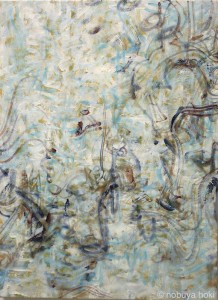Nobuya Hoki Solo Exhibition
2015.11.01 (sun.) – 11.29 (sun.)
open on fri., sat., & sun. 12:00-18:00
appointments are available on weekdays
opening reception : 11.01 (sun.) 18:00-20:00
courtesy of Taka Ishii Gallery
.
Hoki’s paintings consist of three elements, LINES, SMUDGES (done by whiting retouch) and WHITE (paints). Hoki has been working with “verbalization of ‘WHITE’” where he deliberately leaves SMUDGES used to erase unnecessary LINES until those WHITE would convey a significant meaning in his work. In Hoki’s Exhibition at eN arts his new works created by his unique procedures – paint blue-green → draw with brown and navy LINES echoing with the blue & green paints → paint WHITE on top of the blank spaces – will be exhibited. Please enjoy Hoki’s latest works, pictured “the aggressive verbalization of WHITE = WHITE eats LINES” through his paintings where LINES, SMUDGES & WHITE relate one another.
Naomi Rowe | eN arts
.
Smudges
Lines were drawn with pencil on a sheet of white paper. To then correct to the drawer’s desired outcome, three things are created once an eraser is used: Paper (ground), lines, and finally smudges.
If no mistakes are made or if carefully erased, the smudges cannot be seen. All that can be seen is the contrast between the paper and the lines. The smudges are a buffer that gently separates the paper (ground) from the lines, whether or not the lines were not drawn or whether or not the lines did not revert to the ground.
With a slight bias formed by a neutral white (ground), I tried leaving an image on an erasure three years ago. I decided to use the buffer that the smudges are to eliminate the contrast between lines and paper (ground) in an idea that idea might have been a last resort or makeshift measure. From last year, I started to introduce the idea of “verbalizing white” in my works, which is to say I attempted to add consciously created images to the erased white background left from correcting lines and retouching the smudges. Even when retouching lines to white, I wouldn’t erase completely, so that a few smudges would remain. And the white placed on top of the smudges to erase it completely would seem wasted since it was the layering of white on top of white.
In this way, the smudges would assume little by little variations and would naturally show the marks of greater complexity than previous works. But I continue to use white for erasing, and lines for drawing. While at the same time leaving the smudges as a buffer.
Beyond “Unopposed”
By drawing and erasing (or erasing incompletely or drawing incompletely) the smudges are triggered, and the image progresses. If you call the act of erasing and act of drawing conscious acts, then the smudges should be called a nearly unconscious act. But true unconsciousness is probably not something that falls into the gap between one intentional act and another.
In this situation, “unopposed” means simply not failing or having the ability to wait on a decision, so it is not possessing overwhelming strength or power. For example, let’s say you connect a side of a white cube to a black cube and then wrap is round and round with a grey sash. When done, the contrasting black and white somehow appears to be connected. Even if just a bit of the grey is caught in between the cubes, their contrast appears to fade. This is the convenient expedient to be “unopposed” – when things that should normally conflict reject that dynamism, appearing instead to go hand in hand in a world without an exit.
If the smudges are a buffer or cushion, then the work becomes closed. To prevent this outcome, the lines, the white background (ground), and the smudges must be in a three-way deadlock. In addition to the role of each being clear, the outcome depends on what is actually there. This is the ideal state for my works now. Lines, smudges, white ground – although each can be easily recognized in a glance of the eye, what they become changes with each work, even to the extent that the outcomes are decided in a haphazard manner.
It is to consider the outsider gray between the white and black cubes.
Nobuya Hoki
.
.
-WORKS-
-INSTALLATION VIEW-

